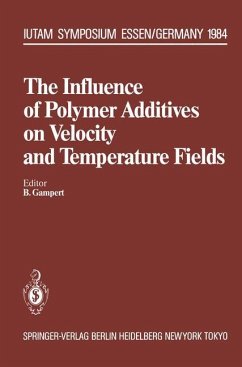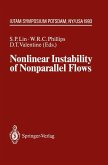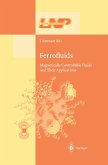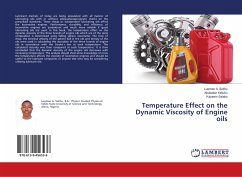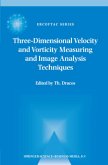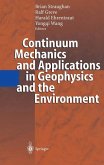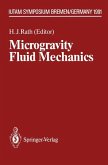The Influence of Polymer Additives on Velocity and Temperature Fields
Symposium Universität ¿ GH ¿ Essen, Germany, June 26¿28, 1984
Herausgegeben von Gampert, Bernhard
The Influence of Polymer Additives on Velocity and Temperature Fields
Symposium Universität ¿ GH ¿ Essen, Germany, June 26¿28, 1984
Herausgegeben von Gampert, Bernhard
- Broschiertes Buch
- Merkliste
- Auf die Merkliste
- Bewerten Bewerten
- Teilen
- Produkt teilen
- Produkterinnerung
- Produkterinnerung
The Symposium on "The Influence of Polymer Additives on Veloc ity and Temperature Fields" was proposed to the General Assem bly of the International Union of Theoretical and Applied Me chanics (IUTAM) by the "Gesellschaft fur Angewandte Mathematik und Mechanik" (GAMM). The Symposium was held under the auspices of IUTAM in association with the "Deutsche Rheologische Ge sellschaft" (DRG) with responsibility for the organization ly ing with B. Gampert (Universitat-GH-Essen). The main aim of this IUTAM Symposium was to consider the funda mental aspects of the phenomena that occur when small…mehr
Andere Kunden interessierten sich auch für
![Nonlinear Instability of Nonparallel Flows Nonlinear Instability of Nonparallel Flows]() Nonlinear Instability of Nonparallel Flows75,99 €
Nonlinear Instability of Nonparallel Flows75,99 €![Ferrofluids Ferrofluids]() Ferrofluids81,99 €
Ferrofluids81,99 €![Stochastic Mechanics of Discrete Media Stochastic Mechanics of Discrete Media]() David R. AxelradStochastic Mechanics of Discrete Media38,99 €
David R. AxelradStochastic Mechanics of Discrete Media38,99 €![Temperature Effect on the Dynamic Viscosity of Engine oils Temperature Effect on the Dynamic Viscosity of Engine oils]() Luqman A. SolihuTemperature Effect on the Dynamic Viscosity of Engine oils26,99 €
Luqman A. SolihuTemperature Effect on the Dynamic Viscosity of Engine oils26,99 €![Three-Dimensional Velocity and Vorticity Measuring and Image Analysis Techniques Three-Dimensional Velocity and Vorticity Measuring and Image Analysis Techniques]() Three-Dimensional Velocity and Vorticity Measuring and Image Analysis Techniques161,99 €
Three-Dimensional Velocity and Vorticity Measuring and Image Analysis Techniques161,99 €![Continuum Mechanics and Applications in Geophysics and the Environment Continuum Mechanics and Applications in Geophysics and the Environment]() Continuum Mechanics and Applications in Geophysics and the Environment75,99 €
Continuum Mechanics and Applications in Geophysics and the Environment75,99 €![Microgravity Fluid Mechanics Microgravity Fluid Mechanics]() Microgravity Fluid Mechanics81,99 €
Microgravity Fluid Mechanics81,99 €-
-
-
The Symposium on "The Influence of Polymer Additives on Veloc ity and Temperature Fields" was proposed to the General Assem bly of the International Union of Theoretical and Applied Me chanics (IUTAM) by the "Gesellschaft fur Angewandte Mathematik und Mechanik" (GAMM). The Symposium was held under the auspices of IUTAM in association with the "Deutsche Rheologische Ge sellschaft" (DRG) with responsibility for the organization ly ing with B. Gampert (Universitat-GH-Essen). The main aim of this IUTAM Symposium was to consider the funda mental aspects of the phenomena that occur when small amounts of polymers are added to turbulent flows (turbulent drag re duction) and laminar porous media flows. In particular atten tion was devoted to - the influence of molecular parameters of the polymers and solution properties, especially the elongational viscosity, on turbulent flow and laminar porous media flow; the influence of polymers on the turbulence structure in polymer drag reduction.
Hinweis: Dieser Artikel kann nur an eine deutsche Lieferadresse ausgeliefert werden.
Hinweis: Dieser Artikel kann nur an eine deutsche Lieferadresse ausgeliefert werden.
Produktdetails
- Produktdetails
- IUTAM Symposia
- Verlag: Springer / Springer Berlin Heidelberg / Springer, Berlin
- Artikelnr. des Verlages: 978-3-642-82634-4
- 1985
- Seitenzahl: 480
- Erscheinungstermin: 16. Dezember 2011
- Englisch
- Abmessung: 235mm x 155mm x 26mm
- Gewicht: 720g
- ISBN-13: 9783642826344
- ISBN-10: 3642826342
- Artikelnr.: 36114303
- Herstellerkennzeichnung Die Herstellerinformationen sind derzeit nicht verfügbar.
- IUTAM Symposia
- Verlag: Springer / Springer Berlin Heidelberg / Springer, Berlin
- Artikelnr. des Verlages: 978-3-642-82634-4
- 1985
- Seitenzahl: 480
- Erscheinungstermin: 16. Dezember 2011
- Englisch
- Abmessung: 235mm x 155mm x 26mm
- Gewicht: 720g
- ISBN-13: 9783642826344
- ISBN-10: 3642826342
- Artikelnr.: 36114303
- Herstellerkennzeichnung Die Herstellerinformationen sind derzeit nicht verfügbar.
Session I.- * Turbulent drag reduction by. polymer additives: a survey.- Session 2 Extensional Viscosity.- * A review on extensional viscosity.- Flow-induced conformation change in dilute polymer solution - A comparison between non-ionic polymers and polyelectrolytes.- The nature of flow through porous media.- An experimental study of polymer induced drag for flows through porous medium.- Session 3 Molecular Parameters I.- * Molecular parameters as a basis of structure-property-relations in the flow of polymer solutions.- Drag reduction of non-ionic surfactant mixtures.- The influence of molecular weight and molecular weight distribution on drag reduction and mechanical degradation in turbulent flow of highly dilute polymer solutions.- Session 4 Molecular Parameters II.- Influence of molecular parameters on laminar non-Newtonian and on turbulent flows of dilute polymer solutions.- The peculiarities of the structure of wall turbulence and the mechanism of drag reduction by polymer additives.- # The influence of molecular mass distribution, size and elasticity of macromolecules on friction reduction effect.- Characterization of dilute Polyacrylamide and polystyrene solutions by means of porous media flow.- The effect of grafted and ungrafted guargum on turbulent flow of water and on hydraulic conductivity of soil.- Session 5 Molecular Parameters III.- * Some fringe effects of the flow on the macromolecules in dilute polymer and on their non-Newtonian behaviour.- Aging of aqueous polymer solutions.- Model for effects of degradation on polymer drag reduction.- Elastico-viscous effects in complex flows.- Session 6 Theories I.- Turbulence measurements with viscoelastic flow in an open channel.- A mechanism for polymer drag reduction.- # A turbulence model for drag reductiondilute polymer solutions in boundary layer on a flat plate.- Session 7 Structures in Turbulence I.- * The structure near the wall in turbulent shear flow.- Statistical measurements in the turbulent flow of dilute drag-reducing polymer solutions in a round tube.- The vorticity diffusion of ?-vortices in drag reducing solutions.- Session 8 Structures in Turbulence II.- Influence of polymer additives on neutral stability of Görtler vortices.- ° Laser-Doppler measurements of vortex-shedding past small circular cylinders in dilute polymer solutions.- Influence of polymer additives on turbulence in a mixing layer.- The turbulent mixing of viscoelastic fluids in pipe flow.- Session 9 Theories II.- * A qualitative understanding of drag reduction by polymers.- Predictions of turbulent drag reduction for a linear viscoelastic fluid.- An engineering approach to modeling complex flow behavior of polymer solutions.- Session 10 Injection Experiments.- Heterogeneous drag reduction in turbulent pipe flow.- Annular injection of concentrated polymer solutions into the wall region of a turbulent pipe flow.- Turbulence structure of a developing duct flow with near-wall injection of drag reducing polymers.- Session II.- * Today and future possibilities of industrial applications of drag reduction.- Session 12 Pressure Fields, Cavitation.- Effects of a non-Newtonian fluid on the velocity distribution and pumping efficiency of peristaltic pumping.- Effect of polymer solutions on tip vortex cavitation.- The influence of non-Newtonian liquids on the cavitation thresholds and on the pressure pulse velocity in two-phase mixtures.- Session 13 Heat and Mass Transfer.- Nucleate boiling in drag-reducing polymer solutions.- Mass transfer in elongational flows of dilute polymer solutions.
Session I.- * Turbulent drag reduction by. polymer additives: a survey.- Session 2 Extensional Viscosity.- * A review on extensional viscosity.- Flow-induced conformation change in dilute polymer solution - A comparison between non-ionic polymers and polyelectrolytes.- The nature of flow through porous media.- An experimental study of polymer induced drag for flows through porous medium.- Session 3 Molecular Parameters I.- * Molecular parameters as a basis of structure-property-relations in the flow of polymer solutions.- Drag reduction of non-ionic surfactant mixtures.- The influence of molecular weight and molecular weight distribution on drag reduction and mechanical degradation in turbulent flow of highly dilute polymer solutions.- Session 4 Molecular Parameters II.- Influence of molecular parameters on laminar non-Newtonian and on turbulent flows of dilute polymer solutions.- The peculiarities of the structure of wall turbulence and the mechanism of drag reduction by polymer additives.- # The influence of molecular mass distribution, size and elasticity of macromolecules on friction reduction effect.- Characterization of dilute Polyacrylamide and polystyrene solutions by means of porous media flow.- The effect of grafted and ungrafted guargum on turbulent flow of water and on hydraulic conductivity of soil.- Session 5 Molecular Parameters III.- * Some fringe effects of the flow on the macromolecules in dilute polymer and on their non-Newtonian behaviour.- Aging of aqueous polymer solutions.- Model for effects of degradation on polymer drag reduction.- Elastico-viscous effects in complex flows.- Session 6 Theories I.- Turbulence measurements with viscoelastic flow in an open channel.- A mechanism for polymer drag reduction.- # A turbulence model for drag reductiondilute polymer solutions in boundary layer on a flat plate.- Session 7 Structures in Turbulence I.- * The structure near the wall in turbulent shear flow.- Statistical measurements in the turbulent flow of dilute drag-reducing polymer solutions in a round tube.- The vorticity diffusion of ?-vortices in drag reducing solutions.- Session 8 Structures in Turbulence II.- Influence of polymer additives on neutral stability of Görtler vortices.- ° Laser-Doppler measurements of vortex-shedding past small circular cylinders in dilute polymer solutions.- Influence of polymer additives on turbulence in a mixing layer.- The turbulent mixing of viscoelastic fluids in pipe flow.- Session 9 Theories II.- * A qualitative understanding of drag reduction by polymers.- Predictions of turbulent drag reduction for a linear viscoelastic fluid.- An engineering approach to modeling complex flow behavior of polymer solutions.- Session 10 Injection Experiments.- Heterogeneous drag reduction in turbulent pipe flow.- Annular injection of concentrated polymer solutions into the wall region of a turbulent pipe flow.- Turbulence structure of a developing duct flow with near-wall injection of drag reducing polymers.- Session II.- * Today and future possibilities of industrial applications of drag reduction.- Session 12 Pressure Fields, Cavitation.- Effects of a non-Newtonian fluid on the velocity distribution and pumping efficiency of peristaltic pumping.- Effect of polymer solutions on tip vortex cavitation.- The influence of non-Newtonian liquids on the cavitation thresholds and on the pressure pulse velocity in two-phase mixtures.- Session 13 Heat and Mass Transfer.- Nucleate boiling in drag-reducing polymer solutions.- Mass transfer in elongational flows of dilute polymer solutions.

